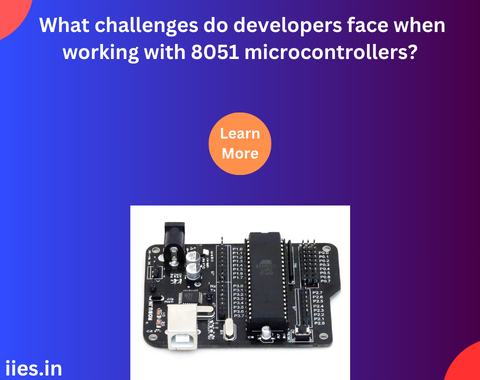
Microcontrollers play a pivotal role in embedded systems, and the 8051 microcontroller family has been a cornerstone in this domain for several decades. Despite its enduring popularity, developers encounter a myriad of challenges when working with 8051 microcontrollers. In this article, we will delve into the key hurdles faced by developers and explore how they navigate these challenges to create robust and efficient embedded systems.
One of the primary challenges when working with 8051 microcontrollers is their limited resources. These microcontrollers often have modest amounts of RAM and ROM, restricting the size and complexity of programs that can be executed. Developers must optimize their code and employ efficient algorithms to make the most of these constrained resources. This requires a deep understanding of the microcontroller’s architecture and careful consideration of every line of code.
Additionally, the limited number of general-purpose I/O pins can pose a challenge in projects requiring numerous interfaced peripherals. Developers often need to resort to multiplexing techniques or external hardware solutions to overcome this limitation, adding complexity to the design.
Lack of Peripheral Integration:
Compared to modern microcontrollers, the 8051 family may lack integrated peripherals. Developers often find themselves incorporating external components for functionalities like USB communication, Ethernet connectivity, or wireless capabilities. This not only increases the cost and complexity of the system but also demands additional efforts in writing and debugging the code for interfacing with these peripherals.
Outdated Development Tools:
The 8051 microcontroller family has been around since the 1980s, and many development tools have become outdated. Limited support for modern integrated development environments (IDEs), debugging tools, and compilers can hinder the development process. Developers may need to rely on legacy tools, making it challenging to leverage the latest advancements in software development.
Inefficient Instruction Set:
The 8051 microcontroller‘s instruction set is considered less efficient compared to contemporary architectures. This can lead to longer execution times for certain operations, affecting the overall performance of the system. Developers often need to employ creative optimization techniques or resort to assembly language programming to squeeze out the maximum performance from the 8051.
Limited Community and Documentation:
While the 8051 microcontroller family has a rich history, its community and documentation may not be as vibrant as those for more modern counterparts. Finding comprehensive resources, tutorials, and community support can be challenging, especially for beginners. Developers may need to rely on outdated or scarce documentation, slowing down the learning and troubleshooting process.
Real-time Constraints:
Many applications of 8051 microcontrollers involve real-time systems, such as control systems or embedded systems in automotive electronics. Meeting real-time constraints can be a challenge, as the microcontroller’s clock speed and interrupt handling capabilities may not be as sophisticated as those of newer counterparts. Developers need to carefully design their systems, prioritize tasks, and implement efficient interrupt service routines to ensure timely responses.
Security Concerns:
Security is a growing concern in embedded systems, and 8051 microcontrollers may lack advanced security features found in more modern architectures. Implementing robust security measures can be challenging, and developers may need to resort to external cryptographic modules or custom solutions, adding complexity to the project.
Interrupt Handling:
While 8051 microcontrollers have interrupt capabilities, their handling mechanisms may not be as advanced as those in more modern microcontroller architectures. Developers must carefully manage interrupt priorities, nesting, and handling to ensure the system responds appropriately to external events. This requires a deep understanding of the microcontroller’s interrupt structure and meticulous programming to avoid conflicts and ensure reliable operation.
Limited Clock Speed:
Clock speed is a critical factor in the performance of microcontrollers. The 8051 microcontroller family may have lower clock speeds compared to contemporary counterparts. This limitation can impact the overall execution speed of the program, making it challenging to meet tight timing constraints in certain applications. Developers need to carefully optimize their code and consider alternative strategies to compensate for the restricted clock speeds.
Incompatibility with Modern Protocols:
As technology evolves, so do communication protocols. 8051 microcontrollers may lack native support for modern communication protocols, such as I2C, SPI, or CAN bus, which are standard in many embedded systems today. Developers often need to implement software-based communication protocols or use external components to bridge the gap between the microcontroller and modern peripherals, adding complexity to the system.
Power Consumption:
Energy efficiency is a crucial consideration in many embedded systems, especially those powered by batteries. The 8051 microcontroller family may not offer the same power management features as more contemporary architectures, leading to challenges in optimizing power consumption. Developers must carefully design their systems to minimize power usage, employing techniques like sleep modes and dynamic clock frequency adjustment.
Limited Support for Multithreading:
Multithreading is a common feature in modern microcontroller architectures, enabling the simultaneous execution of multiple tasks. The 8051 microcontroller family typically lacks native support for true multithreading, requiring developers to implement task scheduling and context switching manually. This adds complexity to the software design and may impact the responsiveness of the system in certain applications.
Cost Considerations:
While the 8051 microcontroller family has a reputation for being cost-effective, the overall cost of a project can increase due to the need for external components, specialized tools, and additional development efforts. Developers must carefully weigh the trade-offs between the cost of using 8051 microcontrollers and the benefits they provide in terms of performance, features, and development ease.
Developing with 8051 microcontrollers presents a unique set of challenges, ranging from resource constraints to outdated development tools. However, with the right knowledge, experience, and creativity, developers can overcome these hurdles and build robust, efficient embedded systems. As technology continues to advance, it remains to be seen how the 8051 microcontroller family will adapt to meet the evolving demands of the embedded systems landscape.
Indian Institute of Embedded Systems – IIES